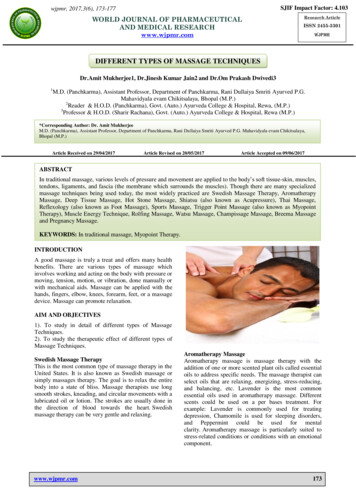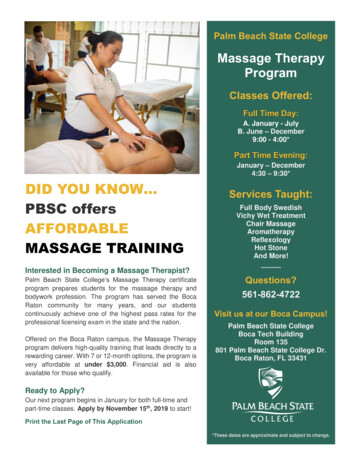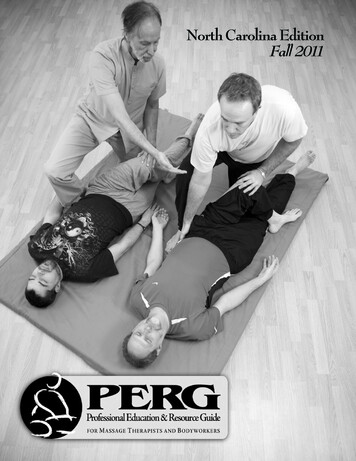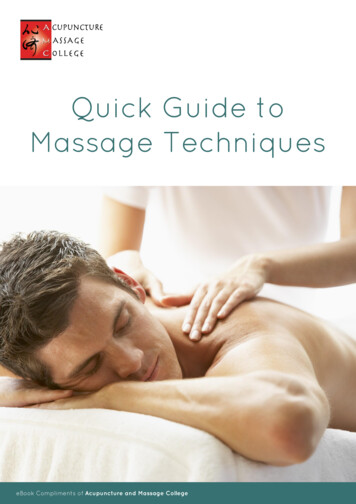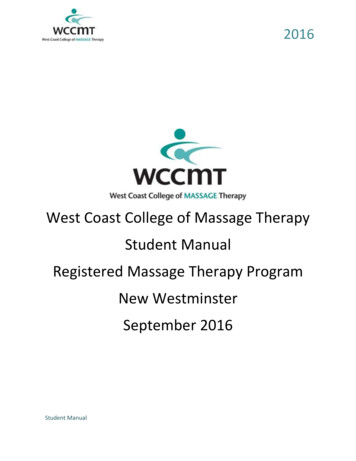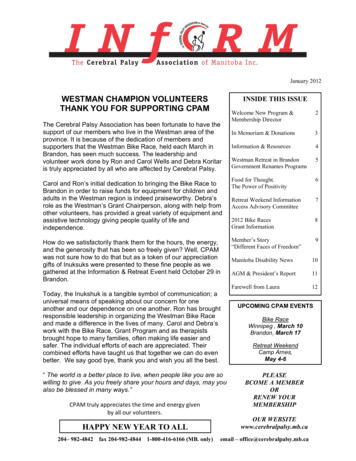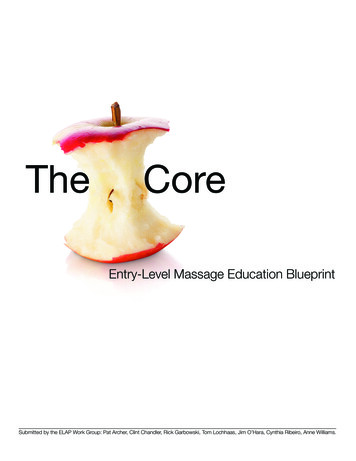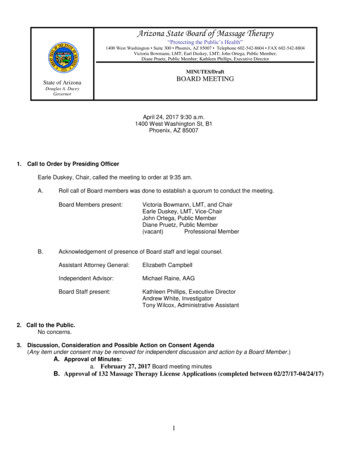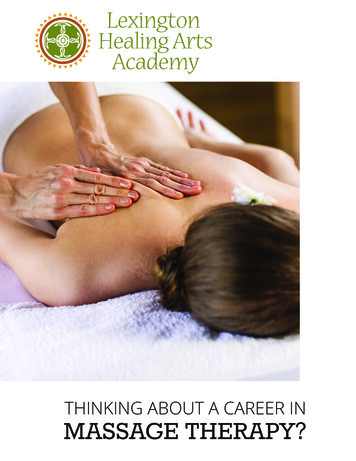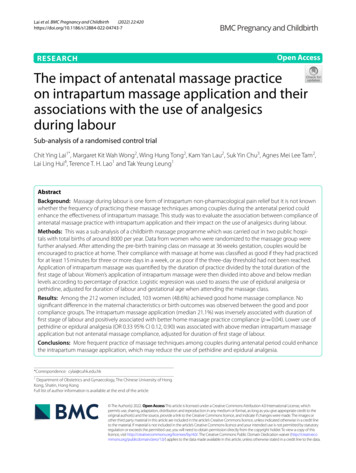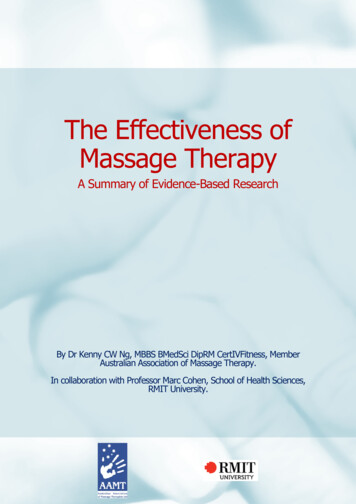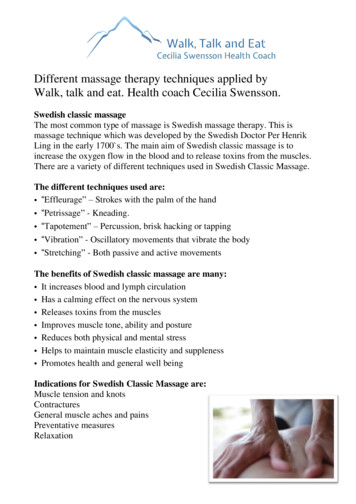
Transcription
Different massage therapy techniques applied byWalk, talk and eat. Health coach Cecilia Swensson.Swedish classic massageThe most common type of massage is Swedish massage therapy. This ismassage technique which was developed by the Swedish Doctor Per HenrikLing in the early 1700 s. The main aim of Swedish classic massage is toincrease the oxygen flow in the blood and to release toxins from the muscles.There are a variety of different techniques used in Swedish Classic Massage.The different techniques used are: “Effleurage” – Strokes with the palm of the hand “Petrissage” - Kneading. “Tapotement” – Percussion, brisk hacking or tapping “Vibration” - Oscillatory movements that vibrate the body “Stretching” - Both passive and active movementsThe benefits of Swedish classic massage are many: It increases blood and lymph circulation Has a calming effect on the nervous system Releases toxins from the muscles Improves muscle tone, ability and posture Reduces both physical and mental stress Helps to maintain muscle elasticity and suppleness Promotes health and general well beingIndications for Swedish Classic Massage are:Muscle tension and knotsContracturesGeneral muscle aches and painsPreventative measuresRelaxation
Sport MassageIs a specific type of massage administered to athletesbefore, during and after any sports activity or event. Avariety of deeper specific techniques are often used inconjunction with both mobilization and stretching. Theycan be used either to address a specific need or injuryand to enhance the performance of the athlete. In thecase of where stress and tension has build up in the softtissues in the body, due to either over abuse or overexertion, sports massage is an effective component inrestoring homeostasis in the muscle tissue.Benefits of Sports Massage: Mobilizes joints and improves the range of movement Reduces muscle tension Improves muscle tone Prevents injuries Enhances performance Drains away fatigue Increases a great sense of well being Increases the blood circulation and lymph flow Relieves pain Reduces the recovery period
Neuromuscular therapy NMTNeuromuscular therapy is a form of soft tissuemanipulation that aims to treat underlying causes ofchronic pain involving the muscular and nervoussystems. This medically oriented form of massageaddresses trigger points (tender muscles points),circulation, nerve compression, postural issues, andbiomechanical problems that can be caused byrepetitive movement injuries.With Neuromuscular therapy the therapist can treatmany different soft tissue problems.NMT assessments and examinations primarilyaddress ischemia (tight tissue with reduced blood flow) myofascial trigger points (hypersensitive points within muscles that giverise to referred phenomena, including pain) neural entrapment (pressure on nerves by muscles and other soft tissues),and nerve compression (pressure on nerves by osseous and other boneliketissues, such as cartilage or discs). postural assessment (assessment of the position of the body as a whole) and dysfunctional gait patterns (manner of movement when walking) with constant consideration for many other perpetuating factors, such ashydration, nutrition, breathing patterns, and psychologic stress.PNF stretching (Proprioceptive Neuromuscular Facilitation)Stretching is an important part of training for any type of sport. PNF stretchingwas originally developed as a form or rehabilitation for stroke patients. Today,it is also used on specific targetedmuscle groups to increase theirflexibility, improve their range ofmovements and enhance muscularstrength.Before any stretching can be performedit is important that the muscles arethoroughly warmed up first to reducethe risk of any injury or harm. This canbe in the form of a massage treatment.
How is PNF performed?The targeted muscle group is firstly passively stretched by the therapist to thepoint where the muscles are stretched under tension.Resistance will then be applied by the therapist to inhibit any movement forapproximately 5-6 seconds.The muscle group is then allowed to relax for a period of 30 seconds where anew controlled stretch is performed for roughly 15-30 seconds.The whole process will be repeated 2-4 times.Myofascial release, Deep Tissue massage (MFR)Fascia is a thin, tough, elastic type of connective tissue that wraps moststructures within the human body, including muscles, like a 3 dimensional net,without any beginning or end. Osteopathic theory proposes that this soft tissuecan become restricted due to psychogenic disease, overuse, trauma, infectiousagents, inactivity or dehydration, often resulting in pain, muscle tension, andcorresponding diminished blood flow, pore posture and restricted movement.Myofascial treatment/Structural deep-tissue massage is a specific type ofmassage therapy that concentrates on the deep layers of muscle and fascia in thebody; By using deep finger pressure and slow, firm strokes, the therapist treatsa variety of physical ailments. When treating the soft tissue of the body with thefascia as focus the therapist work on several muscular groups and connectivetissue in a structural fashion. The fascia gets affected by dehydration, stress,trauma, repetitive movement, inflammation or bad posture. The aim is to restorefunction to a soft tissue area by normalizing the movement in, and between,different structures.Over time, deep-tissue massagetherapy can help break up andeventually erase scar tissue in thebody. It does this by improvinglymphatic circulation and drainageto improve flexibility and range ofmotion in the affected area.Deep-tissue massage can be aneffective treatment for injured
muscles. Because it facilitates the movement of toxins from the muscles andhelps stretch tight or twisted muscle mass, deep-tissue massage can helppromote healing.Contradictions to the above therapeutic massage techniques. Any acute injuries or inflammations Pyrexia (fever) Fractures Tumors Certain heart conditions and venous insufficiency diseasesThai Yoga MassageWith the application of rhythmic pressure on certain energetic points and lines(Sen) in the body and the yogic stretching of muscles and joint manipulation,blockages can be released, and energy can be restored to its natural flow.The massage is usually done on a mat on the floor, fully clothed in loosecomfortable clothes, without oils and sometimes looks like applied hatha yogaor yoga for two! In Thai Massage the Therapist use her hands, elbows, kneesand feet to find the perfect touch needed for the moment. Because this massageis working on the different body layers (koshas) the release works on anemotional, energetic and physical level.The technique can be sometimes static (sinking deeply in a meditative state) orcan move quite dynamically depending.
Thai massage promotes general health and well-being. It has a double purpose. On the preventive side, it actives the free flow of energy and improves fluidcirculation, digestion, breathing capacity, body posture, flexibility, as well asreleasing nervous tension. On the therapeutic side, it can cure a large number of pathologies such aslower back pain, headaches, digestive problems, stress, insomnia, nervousimbalance, neck and shoulder muscular tightness to name just a few Tactile MassageTactile massage is a very gentle non-verbal form ofmassage treatment where the therapist’s hands gentlyactivate the touch receptors in the client’s body.It activates a basic physiological course of events suchas the release of oxytocin, it gives pain relief, itstimulates the parasympathetic nervous system andreduces stress.The massage is given without applying any pressure tothe joints or muscles. Instead a light touch is appliedthrough gentle effleurage and petrissage movements.Tactile massage is administered in a specific way. It is developed according tothe skin’s dermatome (the sensory innervations of the skin) and also accordingto the localization of the touch receptors.Throughout the whole massage the client is completely swept in towels tocreate a warm and safe environment, this also promotes body awareness. Thetreatment is individually adapted to the client’s needs, enabling the client to feelcompletely relaxed and taken care of.
Some of the benefits of tactile massage are It activates the bodys own natural pain killers Promotes a general sense of well being Aids recovery Relaxation Improves sleep Lowers blood pressure Increases body awareness Reduces stress Reduces anxiety Improves bowel movementPrices for any of the above Massage Treatments 55 minutes.At my practice in VerségèresAt your home if you have a massage tableAt your home if I bring a massage tableCHF 90CHF 110CHF 130
Different massage therapy techniques applied by Walk, talk and eat. Health coach Cecilia Swensson. Swedish classic massage The most common type of massage is Swedish massage therapy. This is massage technique which was developed by the Swedish Doctor Per Henrik Ling in the early 1700 s. The main aim of Swedish classic massage is to
